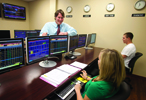Bloomberg Terminals an advantage for Southeastern students
Contact: Tonya Lowentritt
Date: May 24, 2012
Click on thumbnail for high resolution photo
TERMINAL VELOCITY – Southeastern Louisiana University EMBA Director John Cresson observes senior Toni
Bonura of Madisonville as she works at a Bloomberg terminal, in a new, highly specialized
computer laboratory in the College of Business. The new lab gives business students
a competitive edge by exposing them to one of the modern tools used in business today.
HAMMOND –When most people think of a laboratory, images of test tubes and beakers come to mind. However, a different kind of lab was recently installed at Southeastern Louisiana University—this one with special computer terminals linked to immediate stock quotes and related data needed for intense business analysis.
It's the same kind of equipment and access to data that high powered stock brokers are using to analyze fast moving markets, explained John Cresson, associate professor of finance.
"It's all about the students separating themselves from the competition, said Cresson, who is the director of Southeastern's Executive MBA program. "They can use this system for their projects – where they get real-time, up-to-the-minute data – or they can use the Internet, which is what was being used 15 years ago."
The new lab, located in a reconfigured portion in the College of Business' Garrett Hall, features 11 terminals that link to Bloomberg, a major global provider of 24-hour financial news and information, including real time and historic price data, financials data, trading news and analysis, as well as general news. Bloomberg services also offer analytic tools that are typically used by financial specialists.
The Bloomberg Lab, according to Cresson, gives Southeastern students valuable experience in working with one of the high-tech tools of the modern financial world.
"At a recent conference in New York, the participants using Bloomberg commented on how it helps separate them from other schools of business," Cresson said. "With our smaller class sizes, our students are getting more opportunities to work on these specialized terminals."
And with some of the terminals powered by laptop computers, EMBA students – who typically meet in class on Saturdays – will be able to periodically check the machines out of the university for work at home, Cresson said.
The new lab – which includes licenses and computers – was financed with self-generated funds by growing enrollments in the EMBA program, as well as a grant from the Southeastern Student Government Association.
The look and feel of a Bloomberg keyboard is similar to a standard computer keyboard, with the addition of several yellow "hot keys" that identify market sectors, such as government securities, money markets, preferred and equity shares, commodity markets and currency markets. The terminal functions as an application in the Windows environment.
While Bloomberg is known primarily in the financial world, it's not just used for finance. It's also used for business.
"There is supply chain management information, economics, accounting, and statistical data. Students can research a company they may be interested in working for in the future," Cresson said. "Bloomberg has in-house analysts. It's not a substitute for finance; it compliments it. It allows the students to take theory and put it into practice. We don't have to make up numbers or give them cases that happened five years ago. It's all current information. It's a tool that allows the students to put into practice what we teach in the classroom."
Southeastern MBA student and Bloomberg lab graduate assistant Wayne Crawford couldn't agree more.
"Although I am not a finance major, I believe this is a great way for our students to gain an advantage," he said. "The students who use the Bloomberg lab for projects or research and dedicate the extra time are definitely gaining an advantage."
"We have the resources that major private institutions offer, but at a considerably lower tuition," he said. "We have the best of both worlds because we have professors and people with real-world experience, not just graduate assistants, teaching our students."
